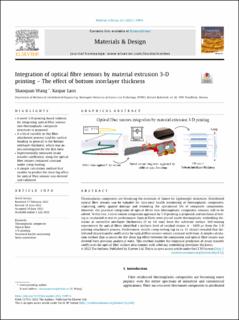| dc.contributor.author | Wang, Shaoquan | |
| dc.contributor.author | Lasn, Kaspar | |
| dc.date.accessioned | 2023-03-07T08:43:43Z | |
| dc.date.available | 2023-03-07T08:43:43Z | |
| dc.date.created | 2022-08-09T14:14:49Z | |
| dc.date.issued | 2022 | |
| dc.identifier.citation | Materials & design. 2022, 221 . | en_US |
| dc.identifier.issn | 0264-1275 | |
| dc.identifier.uri | https://hdl.handle.net/11250/3056235 | |
| dc.description.abstract | Thermoplastic composites are becoming the materials of choice for lightweight structures. Distributed optical fibre sensors can be valuable for structural health monitoring of thermoplastic composites, improving safety against damage and extending the operational life of composite components. However, the practical integration of optical fibres into thermoplastic composites remains still to be solved. To this end, a novel sensor integration approach by 3-D printing is proposed, and mechanical testing is conducted to test its performance. Optical fibres were placed inside thermoplastic embedding elements at controlled interlayer thicknesses (0 to 1.6 mm) from the substrate surface. Self-sensing experiments by optical fibres identified a uniform level of residual strains at −1600 µε from the 3-D printing attachment process. Furthermore, tensile creep testing (up to ca. 1% strain) revealed that distributed strain transfer coefficients for optical fibre sensors remain constant with time. A simple calculation method that accounts for the shear lag effect between the component and optical fibre strains was derived from previous analytical work. This method enables the empirical prediction of strain transfer coefficients for optical fibre surface attachments with arbitrary embedding interlayer thickness. | en_US |
| dc.language.iso | eng | en_US |
| dc.publisher | Elsevier B. V. | en_US |
| dc.rights | Navngivelse 4.0 Internasjonal | * |
| dc.rights.uri | http://creativecommons.org/licenses/by/4.0/deed.no | * |
| dc.title | Integration of optical fibre sensors by material extrusion 3-D printing – The effect of bottom interlayer thickness | en_US |
| dc.title.alternative | Integration of optical fibre sensors by material extrusion 3-D printing – The effect of bottom interlayer thickness | en_US |
| dc.type | Peer reviewed | en_US |
| dc.type | Journal article | en_US |
| dc.description.version | publishedVersion | en_US |
| dc.source.pagenumber | 15 | en_US |
| dc.source.volume | 221 | en_US |
| dc.source.journal | Materials & design | en_US |
| dc.identifier.doi | 10.1016/j.matdes.2022.110914 | |
| dc.identifier.cristin | 2041996 | |
| cristin.ispublished | true | |
| cristin.fulltext | original | |
| cristin.qualitycode | 1 | |

